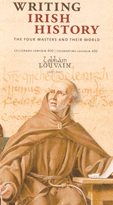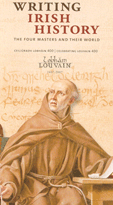Irish in Europe (1600-1800): Shared Histories

 2007 marks the 400th anniversary of the Flight of the Earls, and of the founding of the Irish Franciscan College of St. Anthony’s, in Louvain (Leuven in Belgium). Both are part of a nationwide programme of events commemorating these milestones in Irish history. Lectures, writings and exhibitions are underway in 2007-2008.
2007 marks the 400th anniversary of the Flight of the Earls, and of the founding of the Irish Franciscan College of St. Anthony’s, in Louvain (Leuven in Belgium). Both are part of a nationwide programme of events commemorating these milestones in Irish history. Lectures, writings and exhibitions are underway in 2007-2008.
Louvain 400 is part of the national celebration of Shared Histories organised under the aegis of the Department of the Taoiseach and Department of Arts, Sports and Tourism.
Shared Histories
To commemorate the founding of St. Anthony’s College in 1607, the Irish Franciscans, the Royal Irish Academy, Trinity College and University College Dublin have collaborated in the exhibition Writing Irish History: The Four Masters and their World. On display from October to December in the Long Room, Trinity College Library Dublin, Louvain 1607-2007 brings together the history of the Irish Franciscan College with displays of some of the most important manuscripts in Irish history.
The Irish Colleges, especially the college at Leuven, were to the forefront in publishing scholarly and devotional books. Leuven set up its own printing press with a typeface based on the Gaelic alphabet c.1614: a selection of books from the Library’s rare book collection, which were printed on that press, are displayed in the exhibition.
The Franciscans came to Ireland from England c.1230. The order expanded rapidly and established thirty-two houses or friaries by 1335, chiefly in the towns of the Anglo-Norman colony. Further expansion, into Gaelic territories, occurred with the emergence of the austere Observant reform and by 1540 most of the sixty-one friaries were Observant. Various Franciscan manuscripts, including the late medieval Dublin manuscript containing the oldest surviving copy of the 1224 Rule of St. Francis, are displayed in the exhibition.
National Library of Ireland
A major exhibition Strangers to Citizens: the Irish in Europe, 1600-1800 is to run for twelve months in the Heraldic Museum, Kildare Street. The Library will publish a book The Irish on the move in Europe, 1600-1800 from which we can catch glimpses of the Irish migrants’ achievements in war, trade, politics and religion: and will also give a taste of the more mundane side of migrant life - the constant graft for survival, the casualties of war and social conflict, the sorry fate of the weak, the poor and the sick.
The book offers an illustrated overview of the travels, travails and triumphs of thousands of Irish migrants from all walks of life - students, soldiers, merchants, aristocrats, writers, entrepreneurs, composers and even beggars - who crossed the seas to ports such as Rouen, La Coruna and Ostende from the opening decades of the 1600s onwards. This phenomenon, born of political dislocation in Ireland and the lure of a better life in Europe, would continue until the era of the French Revolution.
The book concludes with a vignette on that extraordinary successful generation of eighteenth century Irish migrants who acted as ambassadors, government ministers, industrialists, writers, medics, bankers and royal mistresses as the storm clouds of European revolution gathered.
Flight of the Earls
Historian, John McCavitt, is author of a new book “The Flight of the Earls - an illustrated history”, the first fully illustrated history of this milestone event.
While people, ideas and goods had always moved between Ireland Europe, the pace quickened after the Nine Years War between the Ulster earls and Queen Elizabeth had reached its climax. The earls’ defeat at Kinsale, and their departure overseas in 1607, unleashed the first wave of Irish migration, mostly of soldiers and their dependents, to Europe.
Irish merchants were key figures in moving the migrating military to the Continent. Their human cargo also included ecclesiastics in search of education and better opportunities. With native ingenuity and foreign patronage they established a network of colleges that eventually extended as far east as Wielun in Poland. Together, Irish soldiers, merchants and clergy left their mark on their host societies.
The main occupation of Irishmen who went to Europe in the seventeenth and eighteenth centuries was soldiering. They joined the armies of Spain, France, Germany, Austria, Russia, Poland and even Sweden. An important element of the Strangers to Citizens exhibition is devoted to telling their story in images and manuscripts.
One particularly interesting aspect of the experience of these Irishmen, who rose to high office in the armies of Europe, is that they were required to present evidence of their aristocratic lineage in order to obtain commissions. Acceptable accreditation took the form of a verified pedigree and coat of arms.
For these, people of Irish descent applied to the Office of Arms in Dublin. Handwritten copies of the pedigrees issued, along with painted illustrations of the coats of arms, were kept by the Office, now a department within the Library, in a series of large registers often referred to as the Wild Geese Registers. A selection of these beautiful manuscripts is displayed, and in addition a ‘turning the pages’ interactive touch screen installation of some of the richest manuscripts is included.
Among the many treasures displayed in the exhibition is the diary of the Flight of the Earls, written by Tadhg 0 Cianain, the Franciscan friar who accompanied Hugh 0’Neill, Earl of Tyrone, Ruairi 0’Donnell, Earl of Tyrconnell, and their large entourage of about ninety people on their journey from Ireland to France and on to Rome, in 1607. Within the weathered covers of this modest volume is preserved a story of intense drama, all the more effective for the minimalist style in which it is written.
Ita Marguet, December 2007
Note: Acknowledgement is given to all sources used in preparation of this text, specifically display Louvain 1607-2007 and National Library of Ireland News, Number 29: Autumn 2007.




